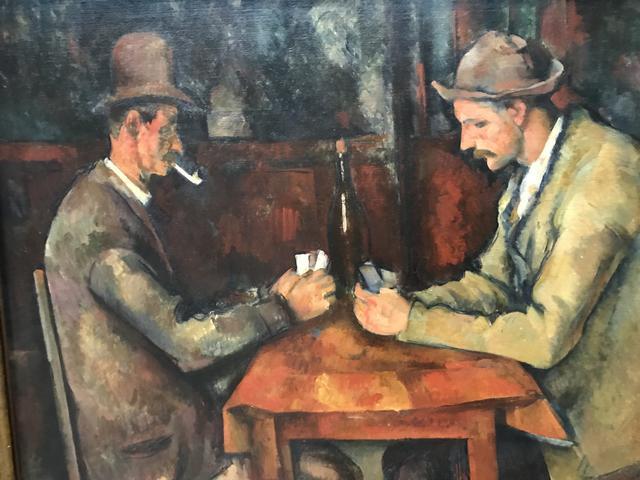The card players

Paul Cézanne's painting "The Card Players" is a masterpiece that showcases the artist's unique approach to capturing everyday life with a touch of sophistication. Created between 1890 and 1895, this painting is a prime example of Cézanne's exploration of the theme inspired by the Le Nain brothers' work, "The Card Players," which he likely saw at the museum in his hometown of Aix-en-Provence.
In this particular piece, Cézanne delves into the Caravagesque-inspired theme with exceptional gravity, focusing on the subtle play of gestures and glances among the characters. The central axis of the composition is the bottle, which reflects light and separates the space into two symmetrical zones, highlighting the opposition between the players. These players are believed to be peasants from Jas de Bouffan, Cézanne's paternal estate near Aix, with the man smoking a pipe identified as "Uncle Alexandre," a local gardener.
Out of the five paintings dedicated to this theme, "The Card Players" stands out as the most sober and monumental. The composition exudes a sense of quiet intensity, with each element contributing to the overall chromatic richness and nuanced details that Cézanne is known for. The recurrence of card players in Cézanne's art has sparked intriguing interpretations, with some suggesting that the confrontation between the players symbolizes the artist's personal struggles and quest for recognition in the art world.
As visitors gaze upon this iconic painting, they are transported into a world where simplicity meets complexity, where everyday scenes are elevated to a level of profound contemplation. The meticulous brushwork, the careful composition, and the emotional depth captured in "The Card Players" invite viewers to ponder the deeper meanings behind the seemingly mundane subject matter. It is a testament to Cézanne's mastery of form, color, and narrative, showcasing his ability to transform ordinary moments into timeless works of art that continue to captivate audiences around the world.
In conclusion, "The Card Players" by Paul Cézanne is not just a painting but a window into the artist's soul, a reflection of his inner struggles and triumphs. It is a piece that transcends time and space, inviting viewers to immerse themselves in the rich tapestry of emotions and narratives woven into its intricate details. As tourists explore museums and cities, encountering such masterpieces allows them to connect with history, culture, and art in a profound and meaningful way.
© ChatGPT 3.5